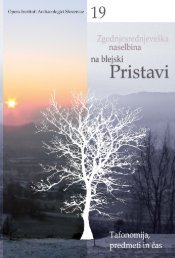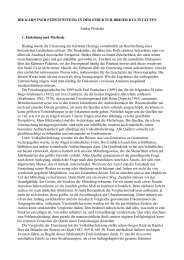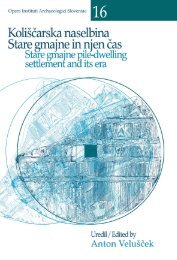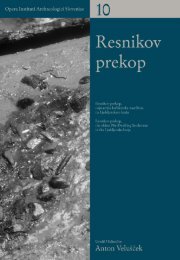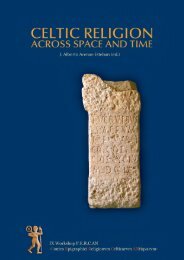The dedication to Antinous from Socanica In the course of ...
The dedication to Antinous from Socanica In the course of ...
The dedication to Antinous from Socanica In the course of ...
You also want an ePaper? Increase the reach of your titles
YUMPU automatically turns print PDFs into web optimized ePapers that Google loves.
182 MARJETA ŠAŠEL KOS<br />
god <strong>from</strong> Aizanoi in Phrygia) <strong>from</strong> <strong>the</strong> Dardanian mining centre<br />
at Ulpiana (20). Clearly, this is only a hypo<strong>the</strong>sis that cannot be<br />
proven on <strong>the</strong> basis <strong>of</strong> <strong>the</strong> extant evidence.<br />
<strong>The</strong> coloni mentioned in <strong>the</strong> <strong>Antinous</strong> inscription are also<br />
mentioned in ano<strong>the</strong>r inscription <strong>from</strong> <strong>Socanica</strong>, where a member<br />
<strong>of</strong> <strong>the</strong> Moesian municipal upper class was honoured in a public<br />
place given by <strong>the</strong> coloni (21). Telesphorus was procura<strong>to</strong>r ra<strong>the</strong>r<br />
than vilicus, as was supposed by Šašel. An augustalis named Telesphorus<br />
is known <strong>from</strong> Viminacium; he was <strong>the</strong> fa<strong>the</strong>r <strong>of</strong> a decurio<br />
and pontifex <strong>of</strong> <strong>the</strong> municipium Aelium Viminacium, [-]atus Restitutus<br />
(22). However, <strong>the</strong>re seems <strong>to</strong> be no connection between<br />
<strong>the</strong> two Telesphori.<br />
An important new find throws interesting light on <strong>the</strong> <strong>Antinous</strong><br />
inscription <strong>from</strong> Soèanica. A fragmentary inscribed architrave<br />
has been discovered in Carnuntum, at <strong>the</strong> cult area on <strong>the</strong><br />
Pfaffenberg hill (23), and was recently res<strong>to</strong>red by Ioan Piso. <strong>The</strong><br />
inscription almost certainly mentions <strong>Antinous</strong>, since <strong>the</strong> letters<br />
[---]noo in connection with L. Aelius Caesar could hardly be<br />
supplemented in a different way, although <strong>the</strong> letter N is not<br />
entirely certain (Fig. 3) (24). L. Aelius Caesar must have <strong>of</strong>ten<br />
stayed in Carnuntum as <strong>the</strong> governor <strong>of</strong> both Pannonias. <strong>The</strong><br />
architrave belonged <strong>to</strong> one <strong>of</strong> <strong>the</strong> three sanctuaries on Pfaffenberg,<br />
temple I, which may have been constructed for <strong>the</strong> deified<br />
<strong>Antinous</strong> (25). If <strong>the</strong> presence <strong>of</strong> <strong>the</strong> worship <strong>of</strong> <strong>Antinous</strong> in<br />
Carnuntum could be proven beyond doubt, this would make <strong>the</strong><br />
hypo<strong>the</strong>sis <strong>of</strong> Bythinian miners having had any major role in<br />
introducing his cult at <strong>Socanica</strong> less likely. <strong>The</strong> introduction <strong>of</strong> <strong>the</strong><br />
worship <strong>of</strong> <strong>Antinous</strong> should be linked exclusively <strong>to</strong> <strong>the</strong> policy <strong>of</strong><br />
Hadrian, implemented by L. Aelius Caesar.<br />
(20) DUŠANIC´ 1971 (cit.), pp. 257-259 = AEp 1972, 502 = ILJug 524 (<strong>the</strong> name <strong>of</strong> <strong>the</strong> god is<br />
transcribed as Ezzanos by Šašel).<br />
(21) ILJug 1380: -] / ornatus or/namentis dec(urionalibus) / col(oniae) Fl(aviae) Scupino/<br />
5 rum et mun(icipi) spl(endidissimi) / Ulp(ianorum) filio pii(ssimo) / l(oco) d(a<strong>to</strong>) d(ecre<strong>to</strong>) co(lonorum).<br />
See also IMS I no. 168 and p. 103 ff.<br />
(22) IMS II, 76.<br />
(23) See M. KANDLER et al., Carnuntum, in <strong>The</strong> Au<strong>to</strong>nomous Towns <strong>of</strong> Noricum and Pannonia.<br />
Pannonia II, eds. M. ŠAŠEL KOS, P. SCHERRER et al. (Situla 42), Ljubljana 2004, pp. 53-55, for a<br />
short description <strong>of</strong> Pfaffenberg.<br />
(24) I. PISO, Das Heiligtum des Jupiter Optimus Maximus auf dem Pfaffenberg/Carnuntum.<br />
Die <strong>In</strong>schriften (Der römische Limes in Österreich 41), Wien 2003, pp. 19-20 no. 4.<br />
(25) PISO 1993/94 (cit. in n. 15).



